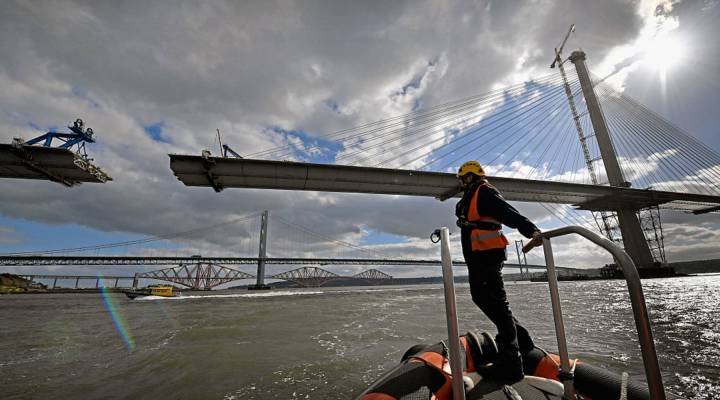
Let’s build infrastructure, but we better make it smart
Share Now on:
Let’s build infrastructure, but we better make it smart

There’s a big conversation happening in America right now about infrastructure. Crumbling roads and bridges, overtaxed airports, ports, and railroads, electric grids, and on and on (not to mention our insecure and insufficient broadband networks).
But the question I’m interested in is whether we will invest in smart infrastructure, and what that might look like. Because as the world gets more connected and digital, there’s a strong argument that our infrastructure needs to incorporate tech, too. I’m talking about everything from bridges with sensors that can monitor their own structural health to connected roadways to full-on smart cities.
If we just blindly build networks of roads and bridges that are just like the ones we built in the 1950s, we could miss out on opportunities to nurture the autonomous car industry, innovative energy technologies, drone delivery airspace, and expanded broadband infrastructure. Or, heck, we might only need half as many actual roads if autonomous cars really do end up dramatically reducing the number of vehicles on them.
Infrastructure investment is a stated goal of President-elect Donald Trump—he originally promised a $1 trillion investment, which then dropped to about half, according to the Trump transition website. But by most analyses, that plan actually depends on investment by private companies who’ll get big tax breaks for embarking on infrastructure projects.
There’s some skepticism about why those private companies might get involved in such large, expensive undertakings, but if they do, maybe that’ll mean they’re also investing in high-tech experiments that could pay off for all of us in the long run. Or maybe the chance to develop and eventually sell futuristic tech will motivate them to invest in the first place.
At CES 2017 in Las Vegas, Panasonic talked about its Enterprise Solutions tech and research center in Denver, Colorado, and the ways it’s working with the city and the state of Colorado to test and build out new infrastructure technologies.
Smart cities start with smart infrastructure. Learn about Panasonic’s city of the future at #CES2017 with @KristyDalton22. #PanasonicCES pic.twitter.com/G4vIWgpHXf
— Panasonic USA (@PanasonicUSA) January 5, 2017
Panasonic and the Colorado Department of Transportation, for example, will test out autonomous cars on a winding stretch of Interstate 70 in that state, and the test will include the cars communicating to each other—vehicle to vehicle—and to the roads themselves, which is known as vehicle-to-infrastructure (or even vehicle-to-x, where “x” is whatever object or landmark the car needs to talk to in order to get information).
And in the city of Denver, the company’s roughly 400-acre research park is generating tech that the city hopes to incorporate everywhere.
“We’ve already got solar canopies over parking lots for example to help us become more efficient at using energy,” Mayor Michael Hancock told me after the press event. “You’re going to see street lights that are more sensor-driven so that they only come on when people or cars or other elements are moving along the streets, traffic signalization become smart so that it keeps traffic moving so it’s not just having you sitting at a light when no one’s coming.”
And Hancock said the city will invest in embedding sensors and other wireless tech into roadways to prepare for autonomous cars that will need to communicate with each other and the streets and streetlights once they start driving around the city.
“The reality is that we’re going to have to think about how we embed those technologies and use some of the greatest innovations that are happening around the world to make that happen,” he said. “Denver is one of the cities that are head of the class, but as a nation we’re kind of behind the 8-ball of some of the other developed countries that are moving forward. Japan, they’re years ahead of the United States. We know we have a long way to go.”
Indeed, few cities seem to be planning for infrastructure that includes either tech itself or even the impact of tech. A November report from the National League of Cities found that only a tiny percent of city transportation plans account for the effects of driverless cars or even a dramatic expansion of ride-sharing.
Most U.S. cities are only in their infancy when it comes to implementing networks of sensors and connected street lights and meters that can communicate real-time information about their traffic, people and energy efficiency. Investment is relatively small—although the Department of Transportation recently put $165 million into smart-city tech as part of the Obama administration’s Smart Cities Initiative.
It’s unclear whether such initiatives will continue under the incoming Trump administration, or how much technology might figure into the administration’s infrastructure plans (the word “technology” does not appear anywhere on the Trump transition’s infrastructure page, although it does briefly address telecommunications). It does, however, call for “a cost-effective system of roads, bridges, tunnels, airports, railroads, ports and waterways, and pipelines in the proud tradition of President Dwight D. Eisenhower.”
Hopefully the administration, or the companies who might commit to future projects, will think of the future and not just the past, or we might be dependent on an infrastructure that holds us back instead of moves us forward.
There’s a lot happening in the world. Through it all, Marketplace is here for you.
You rely on Marketplace to break down the world’s events and tell you how it affects you in a fact-based, approachable way. We rely on your financial support to keep making that possible.
Your donation today powers the independent journalism that you rely on. For just $5/month, you can help sustain Marketplace so we can keep reporting on the things that matter to you.












